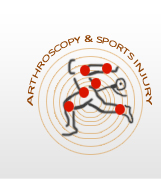| ROTATOR CUFF |
 |
|
|
The shoulder joint consists of a ball and socket, held together with loose ligaments and surrounded by a cloak of tendons called the rotator cuff. There are 4 of these, and they work to keep the ball centred in the socket and help to move the arm in certain directions. Above the rotator cuff tendons is a fluid sac call the bursa which lies between these tendons and the arch of bone forming the point of the shoulder (the acromion). Making up part of this arch is a ligament called the CA ligament. |
| |
|
Structural Damage
Rotator cuff tearing is usually the result of the tendons of the rotator cuff pulling away from the bone which they are attached to. Supraspinatus is the one most frequently torn. Larger tears can involve 2, 3 or all 4 tendons of the rotator cuff. Associated with this tearing is usually an element of inflammation of the bursal sack above the tendons called bursitis and there may be a bone spur present. The thin biceps tendon which passes in front of the shoulder may also be frayed or damaged in conjunction with rotator cuff injuries. |
|
| |
| Symptoms |
| Pain is usually felt over the top and front of the shoulder and may travel down the arm towards the elbow usually on the outside. Some pain may be felt up around the base of the neck and over the shoulder blade at the back. It may be very difficult to lie on the affected shoulder at night time. Weakness may be noticed with progressive difficulty in lifting the arm itself above the level of the shoulder and especially with lifting any objects. |
| |
Rotator cuff tears especially small tears of a single tendon in a person of advanced age can be managed initially without surgery. This treatment includes:
- Avoiding persistent overhead duties or heavy lifting or any other specific aggravating activity.
- Physiotherapy designed to maintain flexibility and improve the strength of the remaining good rotator cuff tendons and also to maintain good posture
- Analgesic and anti-inflammatory tablets.
- Injections of local anaesthetic with cortisone. Excessive use of cortisone is recognized to weaken tendons and should be discouraged.
|
| |
| The Surgery |
| |
|
| |
Shoulder Arthroscopy to repair rotator cuff tears is designed primarily to encourage healing of the tendon back down to the bone. The chance of achieving improvement in pain following rotator cuff surgery however is higher than that of the tendon actually healing. |
| The keyhole technique has some advantages compared with traditional methods of 'open' surgery using larger incisions: |
- Less pain
- Shorter hospital stay (day case or overnight only)
- Faster rehabilitation
- Less pain
- Less stiffness (restriction of movement) following the surgery
- Better ability to identify and treat other areas of damage
|
| |
